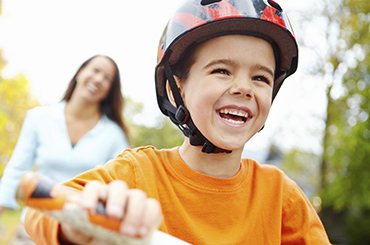Outdoor Safety Tips for Your Children
 With the start of another beautiful Seattle spring and the promise of warmer weather to come, now is a great time to review outdoor safety tips with our children. It is always exciting for families to break out the bikes and skateboards as the days get longer and sunnier. But before you dust off the gear, be sure to brush up on family guidelines for playing safe and answer your kids’ questions.
With the start of another beautiful Seattle spring and the promise of warmer weather to come, now is a great time to review outdoor safety tips with our children. It is always exciting for families to break out the bikes and skateboards as the days get longer and sunnier. But before you dust off the gear, be sure to brush up on family guidelines for playing safe and answer your kids’ questions.
Getting the message across
It has been said that the best way to get your message across is to tailor it to your audience. When talking to kids, be keenly aware of the role their age and maturity plays in their ability to understand and follow the safety advice you give. Parents often underestimate what types of activities their kids will try and overestimate their ability to understand the consequences of the actions they take.
Add in the complication that younger children tend to attempt the awesome stunts that their older siblings and friends execute, and we soon understand that trouble could be lurking around any bend in the trail or over any homemade jump ramp in the neighbor’s driveway.
In general, the younger the child, the physically closer and more vigilant your supervision must be. This is especially true around bodies of open water and parks with beaches.
Also, younger kids often don’t understand the consequences of aggressive behaviors. This means that active play can sometimes spiral out of control and lead to someone getting hurt if a parent is not close by. To help your younger children be prepared for these situations, teach them the importance of asking adults for help when they feel things are getting out of control, feel uncomfortable or get separated from you.
Protective gear
As kids get older, sports and outdoor play are strongly encouraged — along with the appropriate protective gear. Individual and team sports typically have specific recommendations for protective equipment. However, parents who have novice athletes should ask both the coaches and other parents about essential types of safety equipment and their personal gear recommendations.
It is also a great way to see if anyone has second-hand gear to loan or sell so that the costs of outfitting a rapidly growing athlete do not get too exorbitant.
Appropriately fitting helmets, mouth guards and other head protection are especially important for sports such as football, baseball and lacrosse, as well as individual sports including biking, skateboarding and rollerblading. Also look into knee and elbow guards. The use of protective gear should be presented as a basic requirement and not a point of negotiation.
Of course, with the approach of longer days and more sunshine, it is also the perfect time to remind children about the need for sunscreen and sun-protective clothing. I recommend that kids use sunscreen with SPF 30 or higher; apply it at least 15 minutes before going outside and reapply it every two hours. Alternatively, a wide-brimmed hat and sun-protective clothing works well for children who don’t want to follow recommended sunscreen use or who may forget to reapply.
Going it alone
Do your kids like to bike? As the weather gets nice, many children start biking to school and friends’ houses. Reviewing traffic rules and safety tips for bicyclists is extremely important before your child takes off.
Lastly, this is the season when kids may walk to school by themselves or find themselves going to the park alone with greater frequency, so it is important to remind them to not talk to people they don’t know. Go over potential scenarios with your children. Even if they are with a friend, let them know that if they feel uncomfortable for any reason, it is OK to ask to come home.
Your child should be reassured that their safety is always your No. 1 concern and at the forefront of your thoughts throughout their childhood.


